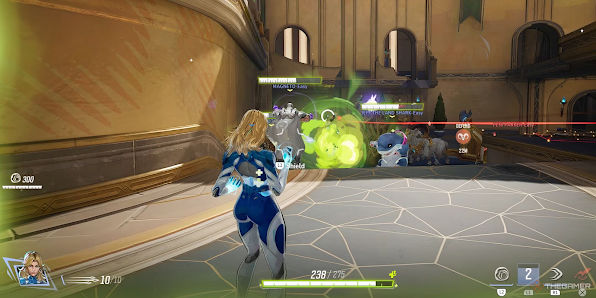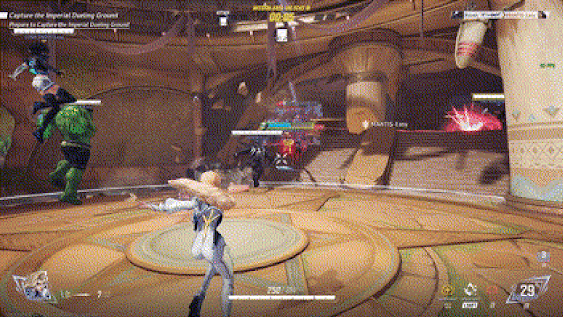Definitive Marvel Rivals Skin Tier Guide (Season 3.5 Update Edition)
Marvel Rivals Season 3.5 brought a vibrant infusion of creativity, chaos, and character customization. This mid-season refresh has delivered a slew of new skins that redefine visual aesthetics across the Marvel universe. From the brooding depths of symbiotic designs to the sun-drenched beach vibes of summer-themed cosmetics, the selection is rich, weird, and, at times, wonderfully absurd.
In this comprehensive visual tier list review, we dissect and rank every skin introduced from the start of Season 3 through the opening of Season 3.5. Expect candid commentary, aesthetic breakdowns, style evaluations, and subjective critique built on fan sentiment and design integrity.
Phoenix Panther: A Missed Opportunity in Fiery Fashion
Tier: C
When Black Panther dons the Phoenix Force, expectations soar. Unfortunately, Phoenix Panther feels underwhelming. The red accents on the claws tease promise, but the overall execution lacks punch. The boots? Forgettable. The crown? Bland. The shoulders? Functionally decorative but visually stagnant.
Compared to Black Panther's legacy of epic skins, this iteration doesn't meet the visual grandeur we've come to expect. As an epic-tier skin, it lands squarely in mediocrity.
Phoenix Widow: Smoldering with Style, But Shy of Spectacular
Tier: B
Widow fares better in her Phoenix incarnation. The flowing shoulder cape adds motion, and her visor-glasses combo injects some sci-fi flair. The fiery highlights are more dynamic than Panther’s, though her design edges into overly suggestive rather than powerfully mystical. Still, there’s effort here—and that effort lifts her just into B tier territory.
Blade (Base Skin): Vampiric Swagger in Peak Form
Tier: S
Blade's arrival brings a powerhouse base skin that delivers on every count. From his modernized trench coat to his holstered vampire stakes, the details ooze personality. The Dracula-inspired sword looks menacing, and his shades lock in the confident anti-hero vibe. The only critique? A missing sword sheath. Yet even that can be forgiven for the sheer execution elsewhere. Easily one of the best base skins in the game.
Daybreak Blade: A Rare Skin with Flashy Confidence
Tier: B
This recolor spins Blade into a bold palette of white, gold, and violet. The visual pop is undeniable. The sunglasses are upgraded and stunning. Still, it doesn’t reach epic heights in design complexity. For a rare-tier skin, though, it’s solid and distinct enough to stand out.
Emerald Blade (Ranked Reward): Loud, But Lacking Finesse
Tier: C
Designed as a gold-ranked reward, the Emerald Blade is a colorful yet chaotic mess. The over-saturated neon green combined with arcade-era influences feels retro but not in a good way. It’s loud, garish, and while some may enjoy the flamboyant flair, it lacks cohesion.
Polarity Edge Blade: Dual Forces in Visual Harmony
Tier: S
This legendary skin is where artistry shines. Polarity Edge Blade blends Phoenix flames with symbiote corruption, crafting a striking duality in every element. Angelic shoulder pads meet corrupted veins; glowing swords contrast with tendrilled weaponry. Even the flaming eye and mismatched earrings work. Easily one of the most inspired designs in the entire game.
Hela – Queen in Black: Wickedly Cool, Subtly Flawed
Tier: A
Channeling the power of Knull, Hela's Queen in Black skin brings limbs snaking around her spine, semi-transparent capes, and a killer hairstyle. There's something deliciously malevolent about it. Still, it leans slightly too hard on body-focused accents, which undermines its gravitas. It's stunning, but not legendary enough to crack the S tier.
Human Torch – First Steps: Cool Colors, Lukewarm Flame
Tier: B
The blue and white aesthetic clashes slightly with Johnny's flame-infused persona. While it nods to cinematic roots, the overall vibe cools the heat too much. It’s well done for a movie homage, but doesn't elevate beyond that. A respectable, but unremarkable epic skin.
Invisible Woman – First Steps: Clean Look, Modest Impact
Tier: B
This is a safe design that changes just enough to stand apart from the default. The hair redesign adds freshness, but the outfit borders on a recolor with minimal adjustments. Still, it's clean and pleasant—just not ambitious.
Loki – Robe of Relaxation: Supreme Summer Mischief
Tier: A
One of the most delightfully absurd skins Marvel Rivals has ever introduced. With crocodile Loki lounging on his neck, rose-tinted glasses, and custom sandals, Loki's summer vacation skin feels iconic. Bonus points for the crocodile scepter. It might not be a "serious" skin, but it's a fan-favorite and visually creative.
Luna Snow – Summer Skin: Cool Concept, Cold Reception
Tier: C
This swimsuit design just doesn’t stick. The icy legs feel awkward, and the overall swimsuit design lacks cohesion. It's not hideous, but it feels more like an early concept sketch than a final product. As a legendary skin, it disappoints.
Mr. Fantastic – First Steps: A Faceless Flop
Tier: C
This skin should have made a stronger statement but fell flat. Missing the white collar flair of his teammates, and bearing a face that looks neither like the comic version nor the film actor, it ends up being the least memorable of the First Steps line.
Emerald Phoenix (Gold Rank Reward): Teal Disappointment
Tier: C
Ironically lacking in actual emerald tones, this skin serves more teal than treasure. Slight back detailing isn't enough to elevate it, and it ends up being one of the most forgettable seasonal reward skins Marvel Rivals has offered.
Psylocke – Summer Skin: Stylish but Subtle
Tier: C
The swimsuit design here is tastefully executed, with appropriate layering and a believable beach aesthetic. But it doesn't scream "legendary." It's a decent seasonal skin, but for a legendary tier, it needs more wow.
Symbiotic Thing: Monstrously Marvelous
Tier: A
Now this is how you do a Thing skin. With tongue-lashing madness and claws to match, Symbiotic Thing transforms Ben Grimm into a nightmare creature with flair. It’s among the most exciting Thing skins to date. Not quite legendary, but thrillingly close.
Thing – First Steps: A Rare Highlight
Tier: B
This one genuinely changes the silhouette and feel of The Thing. Fully decked out in what feels like a space-age suit, it's the most successful of the First Steps series. It has identity and thematic uniqueness.
Summer Thing ("Thong Thing"): Absurd, But Hilarious
Tier: B
A skin that should not work, but somehow does. With just a floral lei and a precarious piece of swimwear, Summer Thing is peak ridiculousness. Fun, weird, and surprisingly popular.
Thor – Summertime Fun: Legendary in Everything But Name
Tier: S
This skin is pure joy. A playful hammer with a translucent frog-thor motif, a mini Loki and Hela peeking from his backpack, and a candy-colored aesthetic that somehow works. This is a swimsuit skin that could have worn a legendary badge with pride. It’s cheerful, full of Marvel in-jokes, and stands out from the crowd.
Final Thoughts: Skins That Soared and Those That Stumbled
Season 3.5 of Marvel Rivals has brought an eclectic mix of bold experimentation and unfortunate mediocrity. While some skins have redefined what's possible in visual storytelling (Blade's Polarity Edge and Thor's Summertime), others missed their mark despite potential (Emerald Phoenix, Luna Snow).
As more updates drop and designs evolve, players can only hope future skins lean into innovation, narrative cohesion, and standout art direction. For now, this ranking represents the high and low points in Marvel Rivals' ongoing journey of visual evolution.
Have thoughts? Want to rank them yourself? Tag us with your own tier list and let’s continue the debate.
🧠 Conclusion: Marvel Rivals Season 3.5 Skins Leave a Mixed Legacy
Marvel Rivals Season 3.5 delivers a wildly eclectic batch of character skins, ranging from jaw-dropping redesigns to underwhelming recolors. While standouts like Blade’s Polarity Edge and Thor’s Summertime splash skin redefine what in-game cosmetics can achieve, others—especially certain rank reward and legendary skins—struggle to justify their prestige classification.
This season's tier list is a reflection of how much artistry, thought, and uniqueness each skin offers to players, not just how flashy they are. Skins are more than costumes—they’re a statement. And in a hero-focused game like Marvel Rivals, where visual storytelling matters, a skin can make all the difference in your emotional connection to a character.
Whether you're grinding for gold-tier rewards or investing in epic bundles, know what’s worth the flex—and what’s better left in your locker.
❓ Marvel Rivals 3.5 Skins Tier List – Frequently Asked Questions
Q: Which skin is considered the best overall in Marvel Rivals Season 3.5?
A: Blade’s Polarity Edge Legendary skin takes the crown for best design and concept fusion. It’s packed with detail, lore relevance, and visual flare.
Q: Are rank reward skins worth grinding for in Season 3.5?
A: Unfortunately, the Emerald variants (Blade & Phoenix) are some of the weakest to date. They're simple recolors lacking the wow factor you'd expect from ranked exclusives.
Q: Which skin is the most controversial or polarizing?
A: Loki’s “Robe of Relaxation” skin received split reactions. Some adore its humor and detail, while others feel it’s too meme-centric for serious play.
Q: Are summer skins in Season 3.5 legendary-worthy?
A: Most aren’t. While Thor’s is arguably the exception, skins like Psylocke’s and Luna Snow’s fail to live up to the Legendary label in terms of depth and uniqueness.
Q: What’s the most underrated skin this season?
A: The Thing’s Symbiotic skin deserves more hype. It’s aggressive, distinctive, and finally gives The Thing a compelling alternate look.
Q: Do any of the Fantastic Four ‘First Steps’ skins stand out?
A: While most are basic movie callbacks, Thing’s and Invisible Woman’s feel slightly more personalized. Mr. Fantastic’s falls flat visually.
Stay Connected with Haplo Gaming Chef
Haplo Gaming Chef blends gaming guides with casual cooking streams for a truly unique viewer experience. Whether you’re here for clean, no-nonsense walkthroughs or just want to chill with some cozy cooking content between game sessions, this is the place for you. From full game unlock guides to live recipe prep and casual chats, Haplo Gaming Chef delivers content that’s both informative and enjoyable.
You Can Follow Along On Every Major Platform:
YouTube, Twitch, TikTok, Instagram, Twitter/X, Threads, Bluesky, Pinterest, Flipboard, Facebook, LinkedIn, Tumblr, Medium, Blogger, and even on Google Business.
No filler, no fluff—just straight-up help for gamers and fun for foodies. Join the community today!
For More Guides Visit: Haplo Gaming Chef Website!



























